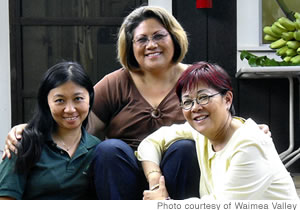Wonders Of Waimea Valley

By Gail Chew
Interim Executive Director for Waimea Valley
As executive director for Waimea Valley, I wanted to share with you that Hi’ipaka LLC is a nonprofit company whose mission is to preserve and perpetuate the human, cultural and natural resources of Waimea through education and stewardship.
The property was acquired as part of a cooperative conservation land purchase intended to permanently protect the valley from commercial development.
This 1,875-acre, nearly intact ‘ahupua’a is significant in Hawaiian history as a repository and cultural site of Hawaiian spirituality, tradition and learning.
Hi’ipaka’s vision is to establish a living pu’uhonua (place of peace and safety) for all who visit - residents and visitors alike.
For kama’aina, our goal is simply to nurture Waimea as a place for artisans and cultural practitioners, students and the community to come together to share and learn.
For others, if they leave Waimea with a greater understanding, appreciation and respect for Hawaii’s people, history, culture and traditions, then we will have been successful.

|
To follow through on our vision, our team includes Josie Hoh, botanical gardens group manager, and Al Lan Diamond, cultural group manager. Hoh says the Waimea Botanical Group manages, conserves and protects the natural habitats of the valley. This includes a 150-acre botanical garden, which contains more than 5,000 documented types of plants, including Hawaii’s finest collection of lo’ulu palms, the only palms to exist in Hawaii before Hawaiians brought coconuts.
Our distinguished collection of plants is displayed amid 35 garden collections, including one solely devoted to the Hawaiian hibiscus plants, which includes our state flower. ‘Alae ‘ula, the endangered Hawaiian moorhen, freely roams here. And Waimea’s Kamananui Stream is home to four out of five species of native freshwater gobies, the ‘o’opu.
Diamond notes the Cultural Group designs and implements programs focused on demonstrating and educating our visitors about Waimea’s human, cultural and natural resources.
In a study conducted by Archaeological Consultants of the Pacific, 78 sites of interest were identified in the valley including religious sites, shrines, house lots, agricultural terraces and ponds.
In addition, we are committed to providing standards-based outreach education programs for students and our island community, and to offer guests an opportunity to experience Waimea Valley through daily guided walks focusing on native plants, valley history, “Meet the Magnificent ‘Alae ‘Ula,” and wildlife, as well as traditional cultural activities.
We’re in the midst of implementing new programs and activities offered nowhere else, such as the Backyard Poi Supper and a unique cultural and historical night walk in the valley.
E-mail this story | Print this page | Comments (0) | Archive | RSS Comments (0) |
Most Recent Comment(s):




 Del.icio.us
Del.icio.us








